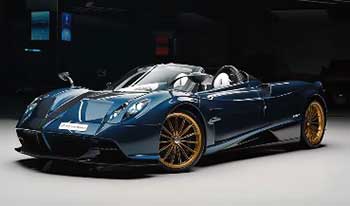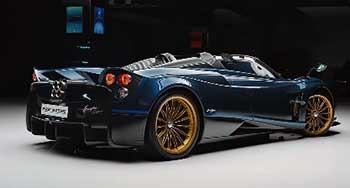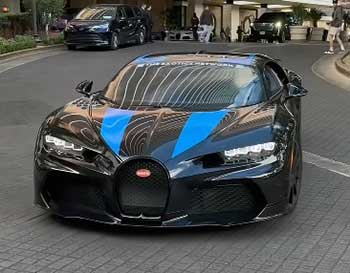I’ve always been fascinated by hypercars, those rare machines that push engineering and design to the absolute limit.
In this article, I’m taking you along for a ride to compare two legends: the Pagani Huayra and the Bugatti Veyron.
From their jaw-dropping performance to their eye-watering price tags, I’ll share my insights on what makes these cars extraordinary, weigh their pros and cons, and offer practical maintenance tips.
By the end, you’ll have a clear picture of which hypercar might steal your heart—or your wallet.
Comparison Table
| Feature | Pagani Huayra | Bugatti Veyron |
|---|---|---|
| Engine | 6.0L V12 Twin-Turbo | 8.0L W16 Quad-Turbo |
| Horsepower | 754 hp | 1,001 hp |
| Top Speed | 238 mph | 254 mph |
| 0-60 mph | 2.8 seconds | 2.5 seconds |
| Weight | 2,976 lbs | 4,162 lbs |
| Transmission | 7-speed sequential | 7-speed dual-clutch |
| Price (Base) | ~$2.5 million | ~$1.7 million |
| Production | Limited (100 units) | Limited (450 units) |
| Drive Type | Rear-wheel drive | All-wheel drive |
My Experience With Pagani Huayra

Stepping into a Pagani Huayra feels like entering a sci-fi masterpiece.
The first thing that hits you is the interior—every surface screams craftsmanship.
It’s not just a car; it’s a rolling sculpture, with leather that feels like it was stitched by angels and carbon fiber that gleams like a futuristic artifact.
The 6.0-liter twin-turbo V12, built by Mercedes-AMG, roars with a primal intensity that makes your spine tingle. When I floored it, the Huayra surged forward with a ferocity that pinned me to the seat, hitting 60 mph in just 2.8 seconds. Its active aerodynamics, with flaps that adjust on the fly, make it feel like the car is dancing through corners.
Driving the Huayra is an emotional experience. It’s raw, almost untamed, yet precise. The steering is razor-sharp, and the suspension, while firm, feels like it’s reading the road’s every nuance. On a winding track, it’s a dream—lightweight at 2,976 pounds, it darts through turns with an agility that heavier hypercars can’t match.
But it’s not perfect for daily driving. The low ground clearance and stiff ride make city streets a challenge, and the sequential gearbox, while lightning-fast, can feel jerky at low speeds. Still, every moment in the Huayra feels like a privilege, a reminder of what human ingenuity can achieve when passion leads the way.
The Huayra’s exclusivity adds to its allure. With only 100 units made, owning one feels like joining an elite club. I remember chatting with a Pagani owner who described the car as “art you can drive.” It’s hard to argue.
From the gullwing doors to the titanium exhaust that sounds like a symphony, this car is about emotion as much as performance. But it’s not without quirks—visibility is limited, and the infotainment system, while bespoke, feels dated compared to modern luxury cars. For me, though, these are minor trade-offs for a car that feels so alive.
Also read: My Thoughts on Acura ILX Vs. Honda Accord
Pros Of Pagani Huayra
- Unparalleled Craftsmanship: The Huayra’s interior is a masterpiece, with hand-stitched leather, polished carbon fiber, and details that make you feel like you’re in a bespoke atelier. Every switch and dial is a work of art.
- Lightweight Design: At under 3,000 pounds, the Huayra is significantly lighter than many hypercars, giving it an edge in agility and handling, especially on twisty tracks.
- Active Aerodynamics: The car’s four adjustable flaps dynamically manage airflow, improving stability and cornering grip without compromising top speed.
- Exhilarating Performance: The 754-horsepower V12 delivers explosive acceleration and a top speed of 238 mph, making it a thrill-seeker’s dream.
- Exclusivity Factor: With only 100 units produced, owning a Huayra is like owning a rare painting—you’re part of an elite group of enthusiasts.
- Unique Sound: The titanium exhaust produces a visceral, almost operatic sound that’s distinct from any other hypercar, turning every drive into a concert.
- Customization Options: Pagani offers near-limitless personalization, from custom paint to bespoke interiors, letting you create a car that’s truly yours.
The Huayra’s strengths lie in its blend of art and performance. I’ve driven cars that are faster in a straight line, but few match the Huayra’s ability to make you feel connected to the road.
Its lightweight chassis and active aero give it a nimbleness that’s rare in this class, and the V12’s howl is something you’ll never forget. The exclusivity and customization options make it feel like a personal statement, not just a vehicle. For someone who values driving dynamics and aesthetic perfection, the Huayra is hard to beat.
Cons Of Pagani Huayra

- High Maintenance Costs: Servicing a Huayra is eye-wateringly expensive, with routine maintenance often costing tens of thousands due to specialized parts and labor.
- Limited Practicality: The low ground clearance and stiff suspension make it impractical for daily driving, especially on rough roads or speed bumps.
- Jerky Gearbox at Low Speeds: The sequential transmission, while fast on the track, can feel clunky in traffic, making stop-and-go driving less smooth.
- Poor Rear Visibility: The small rear window and thick pillars create significant blind spots, which can be nerve-wracking in tight spaces.
- Dated Infotainment: The Huayra’s infotainment system, while custom, lacks the polish and features of modern luxury cars, feeling like an afterthought.
- Limited Dealer Network: Pagani’s small production means few service centers, so you might need to ship your car across continents for repairs.
- Street-Legal Issues: In some regions, including parts of the U.S., the Huayra doesn’t meet emissions or safety standards, limiting its road legality.
Owning a Huayra is a commitment, not just a purchase. The maintenance costs alone can feel like buying a new car every year, and the lack of practicality means it’s more a weekend toy than a daily driver. I found the gearbox’s low-speed behavior frustrating in city settings, and the limited visibility made parking a test of faith.
The infotainment system, while charmingly bespoke, feels like it’s stuck in the early 2010s. And if you’re in the U.S., you might face legal hurdles to even drive it. Still, for the right buyer, these are small prices to pay for such a unique machine.
Maintenance Tips For Pagani Huayra
- Regular Fluid Checks: The Huayra’s V12 is a complex beast, so check oil, coolant, and transmission fluid levels monthly to prevent costly damage.
- Specialized Service Centers: Only use Pagani-approved technicians for repairs; their expertise is critical for maintaining the car’s intricate systems.
- Tire Maintenance: The high-performance tires wear quickly under aggressive driving, so inspect tread depth regularly and replace every 5,000-7,000 miles.
- Carbon Fiber Care: Clean the carbon fiber body with non-abrasive products to preserve its finish; avoid harsh chemicals that can dull the surface.
- Battery Monitoring: The Huayra’s electrical system is sensitive, so use a trickle charger during long storage periods to prevent battery drain.
- Aerodynamic Component Checks: Inspect the active aero flaps for wear or misalignment, as they’re critical for stability at high speeds.
- Store in a Climate-Controlled Garage: Protect the car from humidity and temperature swings to prevent damage to electronics and materials.
Maintaining a Huayra is like caring for a rare piece of art. I learned quickly that regular fluid checks are non-negotiable—the V12 is finicky, and a small oversight can lead to a massive repair bill. Finding a qualified technician is a must; I once heard of an owner flying their car to Italy for a “routine” service. Tires are another headache—those Pirelli P Zeros don’t last long if you’re pushing the car hard.
Keeping the carbon fiber pristine requires gentle care, and the battery needs constant attention during storage. The aero flaps, while genius, need regular inspection to ensure they’re functioning. A climate-controlled garage is your best friend to keep this masterpiece in top shape.
My Experience With Bugatti Veyron
Climbing into a Bugatti Veyron is like stepping into a private jet on wheels. The cabin is plush, with leather and aluminum that exude luxury, though it’s less flamboyant than the Huayra’s. The 8.0-liter quad-turbo W16 engine is a marvel—1,001 horsepower feels like a force of nature.
When I hit the gas, the Veyron launched with a ferocity that blurred the world outside, hitting 60 mph in 2.5 seconds. Its all-wheel-drive system keeps it glued to the road, making high-speed runs feel effortless. At 254 mph, it’s one of the fastest production cars ever built.
The Veyron is a paradox: it’s a 4,162-pound beast that drives like a much lighter car. The dual-clutch gearbox is buttery smooth, even in traffic, and the suspension soaks up bumps better than you’d expect for a hypercar.
On a straightaway, it’s untouchable, with power that feels limitless. But on tight tracks, its weight is noticeable—it’s not as agile as lighter rivals. The cabin is quieter than the Huayra’s, almost too refined for a car this fast. Still, the Veyron’s ability to blend luxury and speed is unmatched, making it feel like a grand tourer with a rocket strapped to it.
Owning a Veyron is a status symbol, but it’s also a commitment. The maintenance costs are astronomical, and the fuel economy—around 9.5L/100km—is laughably bad. But for me, the Veyron’s appeal lies in its audacity.
It’s not just a car; it’s a statement of engineering dominance, backed by Volkswagen’s vast resources. Every drive feels like an event, whether you’re cruising or pushing its limits.
Pros Of Bugatti Veyron

- Monumental Power: The 1,001-horsepower W16 engine delivers mind-bending acceleration and a top speed of 254 mph, making it a straight-line king.
- All-Wheel-Drive Stability: The AWD system ensures incredible traction, letting you unleash the power without fear of losing control.
- Luxurious Interior: The cabin is a blend of high-grade leather and aluminum, offering a level of refinement rare in hypercars.
- Smooth Transmission: The dual-clutch gearbox shifts seamlessly, making it surprisingly easy to drive in city traffic or on the highway.
- Engineering Marvel: Backed by Volkswagen’s resources, the Veyron’s build quality and reliability are exceptional for such a complex machine.
- Iconic Status: As one of the first hypercars to break the 1,000-hp barrier, the Veyron carries a legacy that few cars can match.
- High-Speed Comfort: The suspension and sound insulation make it more comfortable than most hypercars at cruising speeds.
The Veyron’s raw power is its calling card. I’ve never felt anything like the surge of that W16—it’s like being shot out of a cannon. The AWD system gives you confidence to push it hard, and the interior feels like a luxury sedan, not a track weapon.
The dual-clutch gearbox is a godsend in traffic, and the car’s build quality is rock-solid, thanks to VW’s engineering might. Its status as a game-changer in the hypercar world adds to its allure. If you want a car that dominates straightaways and turns heads, the Veyron delivers.
Also read: My Thoughts on Ford Edge Vs. Hyundai Tucson
Cons Of Bugatti Veyron
- Astronomical Maintenance Costs: Annual servicing can cost upwards of $20,000, with tire replacements alone hitting $30,000 every few years.
- Heavy Weight: At 4,162 pounds, the Veyron feels sluggish in tight corners compared to lighter hypercars like the Huayra.
- Poor Fuel Economy: With a 9.5L/100km rating, you’ll be visiting gas stations often, especially during spirited driving.
- Limited Agility: The Veyron’s size and weight make it less nimble on twisty tracks, where lighter cars shine.
- High Depreciation: Despite its high initial cost, the Veyron’s value drops significantly due to its specialized nature and maintenance costs.
- Overly Refined Feel: The quiet cabin and smooth ride can feel too tame for those seeking a raw, visceral driving experience.
- Complex Repairs: Any major repair requires specialized technicians, often meaning long wait times and sky-high bills.
The Veyron’s biggest drawback is its cost to own. I was shocked to learn that a single service could cost as much as a new sports car. Its weight is a constant reminder on tight tracks—it feels like a luxury liner trying to dance.
Fuel economy is abysmal, and depreciation hits hard, even for a car this exclusive. The refined feel, while impressive, can leave thrill-seekers wanting more rawness. Repairs are a logistical nightmare, often requiring parts flown in from Europe. For all its brilliance, the Veyronქ
ron demands serious financial and emotional fortitude.
Maintenance Tips For Bugatti Veyron
- Frequent Oil Changes: The W16 engine requires high-quality synthetic oil changes every 3,000 miles to maintain performance and longevity.
- Tire Inspections: The Veyron’s unique Michelin tires cost thousands to replace, so check for wear regularly and avoid aggressive driving to extend their life.
- Cooling System Maintenance: The quad-turbo system generates immense heat, so inspect coolant levels and radiators monthly to prevent overheating.
- Specialized Service: Only Bugatti-certified technicians should service the car, as its complex systems require expert knowledge.
- Brake Care: The high-performance brakes need regular inspections Nome, inspect pads and rotors every 5,000 miles or after heavy track use.
- Battery Maintenance: Use a trickle charger during storage to keep the battery healthy, as the Veyron’s electronics are power-hungry.
- Protect the Exterior: Use ceramic coating sprays and store the car in a dust-free environment to preserve the paint and carbon fiber.
Keeping a Veyron in top shape is a full-time job. The W16 drinks oil, so I made it a habit to check levels often, using only the best synthetic blends. Those Michelin tires are insanely expensive, so I avoided burnouts to make them last—$30,000 for a set isn’t a joke.
The cooling system is critical; I checked coolant weekly to avoid any heat-related issues. Only Bugatti pros should touch this car—amateur mechanics can do more harm than good. The battery needs regular charging during downtime, and I always used a ceramic coating to protect the exterior. It’s a high-maintenance beast, but worth every effort.
Frequently Asked Questions (FAQ)
The Bugatti Veyron is faster in a straight line, with a top speed of 254 mph compared to the Pagani Huayra’s 238 mph. However, the Huayra’s lighter weight makes it quicker on twisty tracks.
The Pagani Huayra is generally more expensive, starting at around $2.5 million, while the Bugatti Veyron’s base price was about $1.7 million, though special editions can cost more.
The Pagani Huayra doesn’t meet U.S. emissions and safety standards, such as specific airbag and crash-test requirements, making it illegal for road use without special exemptions.
Cars like the Bugatti Chiron (304 mph), Koenigsegg Jesko (over 300 mph), and Hennessey Venom F5 (over 300 mph) surpass the Veyron’s 254 mph top speed.
Conclusion: For Pagani Vs. Bugatti Veyron
You’re now armed with the full scoop on the Pagani Huayra and Bugatti Veyron. The Huayra captivates with its artistry, agility, and exclusivity, perfect for those who crave a visceral, bespoke driving experience.
The Veyron, with its unmatched power and luxury, is the choice for straight-line speed and refined comfort. Both are engineering marvels, but your pick depends on your priorities—raw passion or effortless dominance. Whichever you choose, these hypercars promise a ride like no other. What’s your dream hypercar? Let me know—I’m curious!

